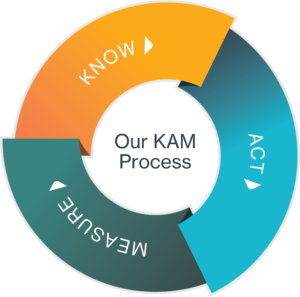Investing in Key Account Management PROCESS Before TOOLS
in Key Account Management /At Kapta, we’re all about technology and we’re proud of the work that we’ve done in creating our account management solutions. The thing is, we know that it’s not the tools that make the key account manager, but it’s their skills and abilities that are the drivers of the real results. The same is true for the account management team as a whole.
If you’re working to either invest in key account management for the first time or want to revamp your existing team, you might fall into a common trap that we see often. People come to us and want to know what software tools they need to get the best results for their organization. Essentially, they want to go to the hardware store and buy every hammer and screwdriver there without fully appreciating what it takes to get the job done without them.
Technology and software can do many great things from saving you time to making your work more efficient during the day-to-day. Even so, nine times out of a ten when an account management leader approaches us looking for the solution to their problems, they want to know how the software will fix issues that go beyond technology.
Since we’re key account managers at heart, we’re not interested in pushing empty promises and tons of licenses for Kapta when we know the problems are bigger than that. Instead, we realize that most of their needs would be better served by getting the process right first, and then worrying about the technology and flashy tools they can use to build upon the process. So, why is this process important and how do you go about improving and investing in your key account management team? Let’s take a closer look.
Why the Process Matters
When you consider the difference between account management and sales or customer service, it all comes down to the process. Key account management is an ongoing process that ideally never ends. You’re building relationships with your customers and working with them for years as you watch their company grow and see them reach their goals and go after new ones.
With sales, on the other hand, the process is all about finding a lead, chasing it down, giving a pitch, and crossing their fingers that they make a purchase. The process really ends there and is repeated over and over again. Key account management isn’t as cut and dry, and when you’re dealing with the top 20% of clients working with your organization, then the results matter. For this reason alone, you can see why investing in technology without an established process won’t do much to create results. You’re essentially getting a new paint job on your car when the engine is what really needs work.
At the end of the day, it might be better to have a crazy good, efficient and thorough process that drives results for your clients and outdated technology than it is to have a bad process and all of the tech in the world. Building your process out first gives your key account management team a solid foundation to build upon and you can then use it as a template toward success for your other clients and any new ones down the road.
When it comes to building this key account management process out, we have a basic framework that we’ve used for success that most account management teams will find useful. Like most of the best things in life, it’s relatively simple, and hopefully, it will inspire you to adjust your strategy and get it built before you start adding more stuff on top of it.
Essentially, it all comes down to Know, Act, and Measure.

Know
Key account management is all about putting the customer and their needs first and above all else. The most effective account managers know their customer’s organization and their industry inside and out and well enough that you might even think they work for them. They have gotten to know their clients over the months and years that they’d had a business relationship and their clients trust them to steer them in the right direction. To put it simply, great key account managers working with a great process know their customers. Do you?
If you feel like you need to refresh yourself on even the surface details of an account before every phone call, it’s time to hit the books and learn more about them. You should be able to confidently speak to clients about their wants, needs, problems, and challenges without coming off like you’re reading from notecards. Their goals are your goals, and their problems are your problems too.
As you start to create your new and improved key account management process, figure out who your customer really is. List the information that you know currently and identify blind spots and areas of confusion. Create a list of questions that you can ask the next time you’re on the phone with a client and update their account plan based on the answers. You might be surprised just how little information you knew about these big players that you’re working with.
Software like Kapta is great for managing all of the data and information you have on your clients, but only you can learn more about them. Until we add a feature in Kapta that calls and holds a conversation with your clients, it’s up to you to gather this information. Pick up the phone and start having regular meetings with the most important customers and make sure that you’re taking down all of the information that you’ll need to know to get them to their goals.
Act
Another thing that software or technology can’t help you do is take action. That’s all on you, and every great key account manager is proactive and works tirelessly to help their clients reach their goals. For this reason, Action is a crucial component of your account management process. Action is where the rubber meets the road and where account managers make a real difference in the life of their account. This is where results happen and if your process is missing this component but has fancy new software, you’re basically spinning your wheels.
So, based off of the knowledge phase, how are you going to help your customers achieve those goals? What are you going to do that no other key account manager could or would do to help them? It’s the answer to that last question that will separate you from all of the other people they work with. It might seem complex and a little abstract to figure out a game plan for such big goals, but it’s possible if you break it down and set responsibilities and expectations for the entire team.
Start with your account plans and outline what your client’s biggest priorities are and when you can reasonably expect to achieve them. Don’t be unrealistic and say you’ll get a three-month initiative done in two days but also set the bar high and aim to exceed their expectations. Then add smaller milestones that will ultimately get to that goal.
For most things, it’s all about understanding what is feasible and what if the most efficient way that you can work. For many of you, efficiency might come from investing in key account management tools and software and that’s okay. It’s just important that you understand why you need the tools instead of blindly subscribing because it’s what all of the big players use.
People power is more effective than technology in this sense, and if you can delegate well and choose tasks for account managers based on their natural talents and skills, you can drive results faster. Work on getting the right action for the right person first and then worry about how software can help you make better decisions for your clients.
Measure
The final component of a solid key account management process is measuring results and taking steps to improve them. If you were to just blindly throw solutions for your clients at the wall with no way to determine if they’re working or not, you’d be running in circles and would be a frustrating service provider. Instead, you need to consider what KPIs you’re measuring, how you’re measuring them, and what you do to implement the data into your account management processes.
While every team will have different metrics to track, we often advise that you have some form of a process to measure outputs and inputs. Your inputs will drive your outputs in a sense and they should do so at an efficient rate. For example, every call that you have with a client could be considered an input, and the output would be them ordering more products from you or scaling their campaign. You want to find the balance between your inputs and outputs where you’re minimizing your inputs while maximizing your outputs. This is what a smooth-running key account management system does. It hardly feels like work and you’re driving results with minimal effort.
You also want to ensure that you have accountability measures in place. This way, should something go wrong, you know who is to blame and who is responsible. It’s all about pinpointing a problem and taking action to correct it without wasting everyone’s time. It also serves as a contingency so the team knows what to do when any specific situation arises and they know who to get in touch with to resolve the problem.
All of these measurement factors are crucial to your account management team’s success. Your process should be measurable with KPIs that you can track weekly and adjust performance accordingly. Once you have a solid foundation built and a team that believes in the process, you’re in a better spot to invest in software tools to help you get your job done and the rollout process will be much smoother too.
Summary
It’s easy to get caught up in the shiny new software that’s out there. Why do you think we worked so hard to make Kapta incredibly attractive? We’d be doing a disservice to key account management teams if we didn’t tell the truth about investing in the process over tools, however. Without a solid process, all you have is a tool that you can’t use to full effect. It’s almost like buying a shiny new cordless drill without any screws. Yeah, it’s cool to look at, but it isn’t really doing much good for you.
Our KAM process is a proven methodology for driving customer engagement through Key Account Management: Know more, so you can plan better. Act strategically and effectively to drive meaningful change. Measure that change across multiple indicators. This process is supported and accelerated by our intuitive technology every step of the way, so you have the tools you need to transform relationships with:
• Your customers: Kapta helps you put customers first, aligning their success with yours so everyone wins
• Your team: Kapta gives you clear performance insights, along with a built-in framework for leadership, mentorship, and growth
• Your tech: Kapta helps build consistent, tech-enabled processes, so you can get the best from your people and your platforms
About Kapta
Kapta believes in relationships first, and number-crunching second. The Kapta platform was developed to make the modern key account manager’s life easier. Rather than spending every day bouncing from app to app and staring at spreadsheets, Kapta does all of the technical work so you can get on the phone and build relationships with your customers. Kapta is the KAM platform that account managers rely on to become the Trusted Advisor for their clients and is a crucial tool to create mutual success. Built into the platform you’ll find powerful tools like Voice of Customer (VOC) Insights, account health scores, account planning templates, and so much more.







